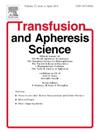Long-term complications, survival and mortality in splenectomised adult transfusion-dependent thalassemia patients
IF 1.4
4区 医学
Q4 HEMATOLOGY
引用次数: 0
Abstract
Background
Splenectomy is frequently performed in transfusion-dependent thalassemia (TDT) patients to lower blood transfusion needs but is associated with significant long-term complications, including sepsis, thrombosis, and pulmonary hypertension. This study examines the long-term complications, survival rates, and causes of mortality among adult patients with TDT who have undergone splenectomy in a low and middle-income country (LMIC).
Methods
A retrospective analysis was conducted on 103 adult TDT patients (≥18 years) who underwent splenectomy between July 2013 and March 2024. Data collected included demographic and clinical characteristics, haematological parameters, transfusion requirements before splenectomy and at the last follow-up, survival rates, complications, and mortality causes.
Results
The median age at splenectomy was 12 years (range 5–34). The majority (98 %) underwent open splenectomy. The yearly transfusion volume decreased from 276.7 ml/kg/year pre-splenectomy (range 207–433) to 146.2 (range 0–252.9) post-splenectomy at the last follow-up, p < 0.0001. Three patients were completely transfusion-free at the last follow-up. Complications included pulmonary hypertension in 10 (9.7 %), thrombosis in 5 (4.8 %), and overwhelming post-splenectomy infection (OPSI) in 4 (3.9 %). The iron-overload-related complications included cardiomyopathy in 17 (16.5 %), endocrinopathy in 56 (54.3 %), chronic liver disease in 15 (14.5 %) and hepatocellular carcinoma in 2 (0.9 %). The 15-year post-splenectomy overall survival (OS) was 84.7 % (95 % CI- 77.3 % - 92.8 %), with 17 deaths (16.5 %) recorded. Iron-overload-related cardiomyopathy was the leading cause of death in 8 (53.3 %).
Conclusion
Splenectomy significantly reduces transfusion requirements in TDT patients but is associated with risks such as thrombosis, pulmonary hypertension, and OPSI. Long-term mortality is primarily driven by iron-overload-related cardiomyopathy.
脾切除成人输血依赖型地中海贫血患者的长期并发症、生存率和死亡率。
背景:脾切除术常用于输血依赖型地中海贫血(TDT)患者,以降低输血需求,但与严重的长期并发症相关,包括败血症、血栓形成和肺动脉高压。本研究调查了低收入和中等收入国家(LMIC)接受脾切除术的成年TDT患者的长期并发症、生存率和死亡原因。方法:回顾性分析2013年7月至2024年3月行脾切除术的103例成人TDT患者(≥18岁)。收集的数据包括人口统计学和临床特征、血液学参数、脾切除术前和最后一次随访时的输血需求、生存率、并发症和死亡原因。结果:脾切除术的中位年龄为12岁(范围5-34岁)。大多数(98 %)行开腹脾切除术。最后一次随访时,年输血量从脾切除术前的276.7 ml/kg/年(范围207-433)降至脾切除术后的146.2 ml/kg/年(范围0-252.9),p 结论:脾切除术显著降低了TDT患者的输血需求,但与血栓形成、肺动脉高压和OPSI等风险相关。长期死亡率主要是由铁超载相关的心肌病引起的。
本文章由计算机程序翻译,如有差异,请以英文原文为准。
求助全文
约1分钟内获得全文
求助全文
来源期刊
CiteScore
3.60
自引率
5.30%
发文量
181
审稿时长
42 days
期刊介绍:
Transfusion and Apheresis Science brings comprehensive and up-to-date information to physicians and health care professionals involved in the rapidly changing fields of transfusion medicine, hemostasis and apheresis. The journal presents original articles relating to scientific and clinical studies in the areas of immunohematology, transfusion practice, bleeding and thrombotic disorders and both therapeutic and donor apheresis including hematopoietic stem cells. Topics covered include the collection and processing of blood, compatibility testing and guidelines for the use of blood products, as well as screening for and transmission of blood-borne diseases. All areas of apheresis - therapeutic and collection - are also addressed. We would like to specifically encourage allied health professionals in this area to submit manuscripts that relate to improved patient and donor care, technical aspects and educational issues.
Transfusion and Apheresis Science features a "Theme" section which includes, in each issue, a group of papers designed to review a specific topic of current importance in transfusion and hemostasis for the discussion of topical issues specific to apheresis and focuses on the operators'' viewpoint. Another section is "What''s Happening" which provides informal reporting of activities in the field. In addition, brief case reports and Letters to the Editor, as well as reviews of meetings and events of general interest, and a listing of recent patents make the journal a complete source of information for practitioners of transfusion, hemostasis and apheresis science. Immediate dissemination of important information is ensured by the commitment of Transfusion and Apheresis Science to rapid publication of both symposia and submitted papers.

 求助内容:
求助内容: 应助结果提醒方式:
应助结果提醒方式:


